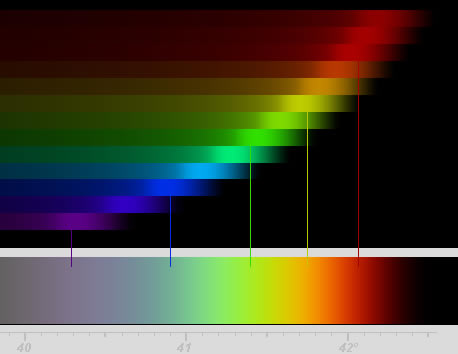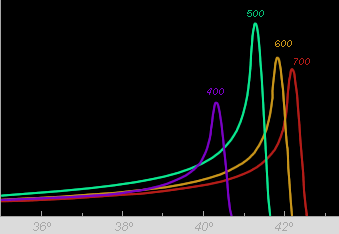
OpticsPOD
What's New
Rays & Shadows
Water Droplets
Rainbows
Not a rainbow!
Primary Bow
Raindrop Rays
Rainbow Cone
Low & High Bows
Drop size
Colours
Secondary Bow
A's Dark Band
Other Orders
Supernumeraries
Red Bows
Rainbow Wheel
Dew Bow
Sea Spray Bow
Glass Bead Bows
Reflection Bows
Twinned Bows
Cloud Bows
Moon Bows
Image Gallery
Simulators
Ice Halos
High Atmosphere
Links & Resources
Search - Index
123456789012345678
| Primary rainbow colours |
|
Traditionally,
the rainbow's colours are described as red,
orange, yellow, green,blue, indigo and violet. In fact,
our eyes can discern many more indivual hues. Rainbow colours are not "pure". The classical rainbow*, is made up of overlapping bows of individually pure spectral colours. Only a few examples are shown at left. The final colours that we see are mixtures. Any one colour of the bow has longer wavelength (towards red) colours mixed in. Look for instance at the blue; there are significant amounts of green present and lesser amounts of yellow and red. Compare this classical bow with one made from small raindrops. |
The peaks are at angles of minimum deviation. The angular size of the sun broadens each peak but there is a more severe smearing effect. Rays deviated more than the minimum deviation angle send light inside the bow and so the light of any particular wavelength falls off slowly towards the bow's center. Think of rainbows more as overlapping bright edged disks rather than narrow coloured rings. The peak intensity for any wavelength has mixed in with it contributions from all the longer wavelengths. Yellow is contaminated with reds, green with yellows and reds and so on. Well inside the main bow all these colours mix to form white. Rainbow colours are not pure. Those of the circumzenithal arc ice crystal halo are purer. |
* |
The classical rainbow is one made from sufficiently large drops that diffraction effects are not apparent (when made by the sun - but see this bow). The colour cross sections at top were computed using geometric optics to trace rays through a spherical drop and then summing the contributions at each deviation angle. Results were convoluted over the angular diameter of the sun. The composite bow's colours were then weighted by the spectral intensity distribution of sunlight at the earth's surface. |


